The Kid's Guide to Home Computers
A paperback book
In my stash of retro computing reading material I came across a small paperback book called The Kid’s Guide to Home Computers.
Thie book 118-page book by Daniel and Susan Cohen came out in 1983 and sold for $1.95 (about $6 today). This book looks vaguely familiar to me, but I don’t think it was one I had back then.
It consists of 14 chapters:
Bringing Home…



